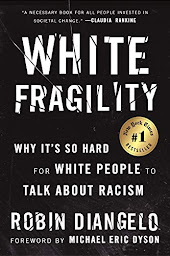Do You Want to Learn about Antiracism?
What is it about the death of George Floyd on May 25, 2020, that shocked us, set it apart from other such deaths, and spurred the ongoing protests? Was it the juxtaposition of the pettiness of the offense of passing a bad $20 bill and the fatal end result? No, we’d seen that before, when Sandra Bland was arrested for a minor traffic violation and ended up hanged in a jail cell. Was it the desperation in Mr. Floyd’s gasp, “I can’t breathe”? No, we’d heard that from Eric Garner, who was selling “loosies” and died as a result of a police chokehold. Was it the pathos caused by watching a fellow human being’s final moments of life? No, sadly, we’d seen Ahmaud Arbery lose his life after being shot while jogging in his neighborhood.
So why has George Floyd’s death moved so many people to act? Why is there now so much momentum behind the movement to keep racial injustice in the public eye? Why are Confederate monuments being removed from public spaces and many antiracism bills being introduced in Congress? No matter the reason, people have become socially aware and are interested in learning more about social justice, racism, and the color disparities in healthcare, education, housing, and employment.
“Lift Ev'ry Voice and Sing,” often referred to as the Black national anthem, is a song that was written as a poem by James Weldon Johnson (1871–1938) in 1900 and set to music by his brother, J. Rosamond Johnson (1873–1954) in 1905. Black voices have been singing to a white country for 400 years. The tone has changed, and the words have changed, but the message has not.
“My Dungeon Shook: Letter to My Nephew on the 100th Anniversary of the Emancipation,” by James Baldwin, appeared in The Progressive in 1962. It was republished as part of The Fire Next Time, in 1963, by Dial Press. Baldwin’s letter to his 14-year-old nephew was a searing history of the collective experience of Black men in America and a commission to use his righteous anger to fuel his understanding of the interception of the Black and white worlds.
In 2015, Ta-Nehisi Coates wrote a letter to his son that was published in The Atlantic. Considered a modern rendering of Baldwin’s letter, and later expanded into Between the World and Me, published in 2016 by Spiegal and Grau, Coates considers the Black and white worlds three quarters of a century after Baldwin. Coates also addresses an African American teenage boy. Where Baldwin hoped for a better future, Coates finds no reason to believe white supremacy will ever end in this country.
We realize that this blog post poses more questions than answers. We recommend learning about antiracism by reading books such as those listed below, which describe the place occupied by Black people in our history and society, as Black writers describe them.
(All titles available in Mercer County Library’s physical or virtual collections)
“When George Yancy penned a New York Times op-ed entitled 'Dear White America' asking white Americans to confront the ways that they benefit from racism … he was unprepared for the flood of vitriol in response. … Yancy quickly discovered that racism is still alive, crude, and vicious in its expression. … Yancy challenges white Americans to rise above the vitriol and to develop a new empathy for the African American experience.” —Publisher
“In a profound work that pivots from the biggest questions about American history and ideals to the most intimate concerns of a father for his son, Ta-Nehisi Coates offers a powerful new framework for understanding our nation’s history and current crisis.” —Publisher
“Author Brian Armstrong tells the shocking story of this ‘sundown town’ and how it evolved into the diverse community that exists today.” —Publisher
“Kendi asks us to think about what an antiracist society might look like, and how we can play an active role in building it.” —Publisher
A powerful true story about the potential for mercy to redeem us, and a clarion call to fix our broken system of justice—from one of the most brilliant and influential lawyers of our time.” —Publisher
“Me and White Supremacy teaches readers how to dismantle the privilege within themselves so that they can stop (often unconsciously) inflicting damage on people of color, and in turn, help other white people do better, too.” —Publisher
“This book directly challenges the notion that the election of Barack Obama signals a new era of colorblindness. With dazzling candor, legal scholar Michelle Alexander argues that ‘we have not ended racial caste in America; we have merely redesigned it.’” —Publisher
“The chapters here feature prominent African American legal minds grappling with the process of identifying legal priorities relating to race and justice. A variety of topics are touched upon: investing in local activism; coalition building among racial, social, and economic lines; countering post-Obama backlash to legal reform; working against the school-to-prison pipeline; and enforcing citizens' guaranteed rights.” —Tiffeni Fontno, Boston Coll. © Copyright 2018. Library Journals LLC.
“A current, constructive, and actionable exploration of today’s racial landscape, offering straightforward clarity that readers of all races need to contribute to the dismantling of the racial divide.” —Publisher
“Championing human rights in the face of violent racism, Patrisse is a survivor. She transformed her personal pain into political power, giving voice to a people suffering inequality and a movement fueled by her strength and love, to tell the country—and the world—that Black Lives Matter.” —Publisher
“DiAngelo explores how white fragility develops, how it protects racial inequality, and what we can do to engage more constructively.” —Publisher
"Exploring issues from eradicated black history to the political purpose of white dominance, whitewashed feminism to the inextricable link between class and race, Reni Eddo-Lodge offers a new framework for how to see, acknowledge and counter racism today.” —Publisher












Comments
Post a Comment